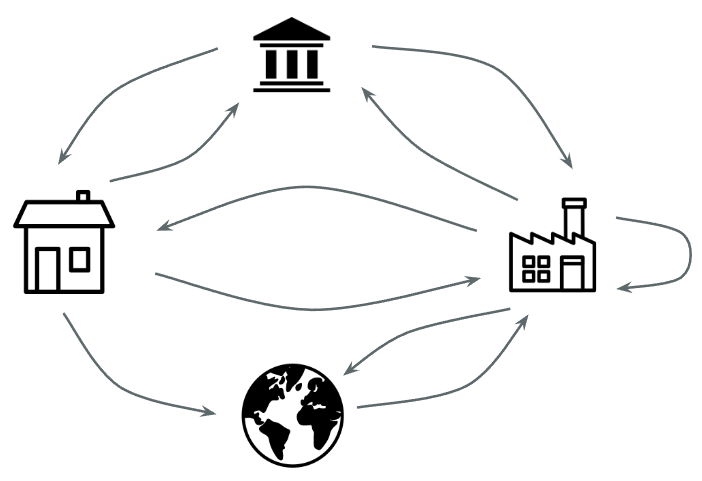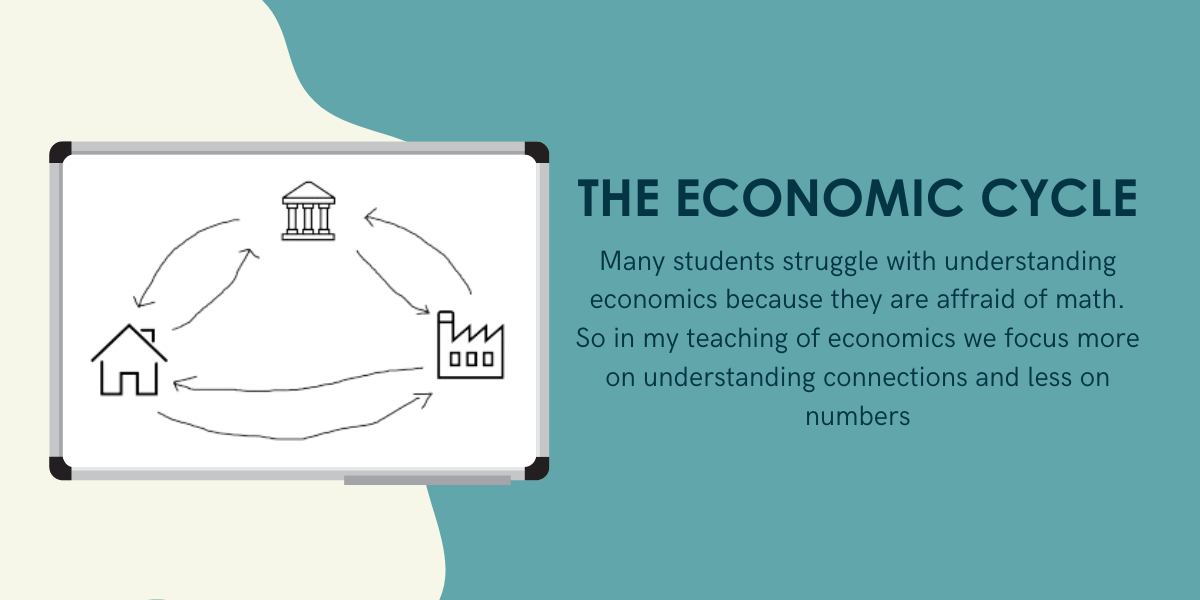When teaching the economic cycle and economics in general we run into a lot of students who struggle with math, because they think it is about math. By instead focusing on teaching them how to think about economic connections and to think methodical through the problem, we get around that blocage. Instead we want to show them that when something changes in one part of the system it has ripple effect in the rest of the economy.
Solution: teaching the economic cycle in high school
When teaching the economic cycle in high school it’s a good idea to be using drawings and down to earth examples to explain complex society wide problems and connects. I always have the student draw along when I do this lesson and have them do small 3-4 minute exercises in between me talking.

The lesson: The simple economic cycle
- I start out by handing out two pieces of paper, one color and one not*. I tell them that for this lesson they are not allowed to take notes on their computers. I then divide the whiteboard into two areas. I tell them that everything on the left side should be drawn on their colored paper and the right side is for other notes and that should go on the white paper.
- I then tell them that we will talk about a tiny island society out in the middle of the sea what does not have any contact with the rest of the world. In other words it is a closed economy. We then name the island together – which always have them laughing and it is now their island – go ownership.
- Once the setup is done I explain that the island has some people living on it (drawing a house) and that they work in companies (drawing the factory). As I draw, I ask the students to draw with me and add notes to their own drawing. I when add the arrows with the connections between the workplace and the households. As much as possible I get the students to explain the connections.
- When I move to the other side of the whiteboard and set up a scenario. For instance a new company opens. We when go over the effects on the rest of the economy (a rise in production leading to more workers being paid, leading to a rise in consumption, leading to a raise in demand, leading to a raise in production etc.)
- Once everyone gets how that works, I give them a scenario to puzzle out in pairs. I get someone to explain it for everyone once they have had a few minutes to work it out. We work over 2-4 scenarios in this manner until everyone gets it.
- All the scenarios are a bit silly but also rather concret. What would happen if the public believed that a bad winter was coming? What would happen if the shoe factory shut down? What would happen if the ceo of the crisps company had heard that a magazine would run an article saying that crisps were really healthy?
- Once they get the connections between the household economy and the companies economy we move back to left whiteboard and add the state. They draw it in on their notepaper and we move back to the right whiteboard. Every time I run over the connections as they explain them I move back to the left whiteboard and point to where we are in the cycle.
- With the state involved we try to figure out how the sceneries from before would hurt or help the state’s revenue stream.
The students tend to really like this lesson because it is both hands on and teacher lead. Quite a few of my students gets anxious if the lessons were too free form. Everyone gets to work out how the economy works. The visual learners are very happy and so are the audio learners as well as the analytical ones. It is fun because of the silly examples I tend to conjure up.
Taking it further
Once we are done teaching the simple economic cycle, we can start talking about the more complicated economics theory and one of the things they also need to learn about is economical policy. I have them bring the colored notes again and we look at different scenarios where the state is actively manipulating the economy. It is much easier for them to think this through once they got the ground work without an active state.
This tend to pay of when exams comes around because they can demonstrate that they understand why we get a rise in import with a tax cut or why inflation happens in a economic growth period.
I am also thinking that my sticky note visualisation might work really well with this kind of scenarios. I am thinking that moving the sticky notes with the different effects around might prove really useful for remembering how it works.
*My students don’t tend to bring their own notebooks – instead of struggling with this I have started bring paper when it is important.
Originally posted: June 25, 2015
Updated: June 21, 2023
About me as a teacher
I teach social studies and history at a high school level in Denmark. I teach mostly samfundsfag C & B and History as part of KS (cultural studies). I have been teaching for more than ten years.
I have a masters in history from Aarhus University and I minored in social studies. Read more about me and see my teaching resume.
I choose to write my teaching blog posts in English because I want to give back to the teaching community that inspires me.



Leave a Reply